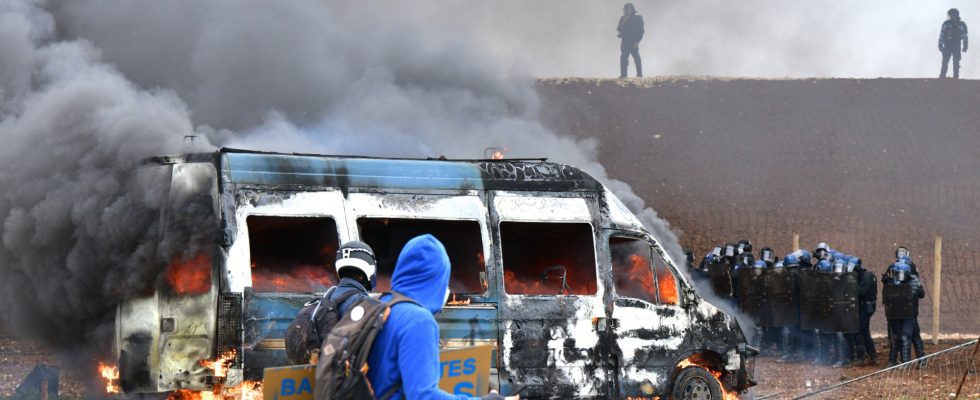Guillaume Dominguez with AFP
modified to
7:43 p.m., March 26, 2023
A demonstrator is between life and death after violent clashes with the police on Saturday in Deux-Sèvres, for which authorities and organizers reject responsibility against a backdrop of opposition to a water reservoir project. The vital prognosis of this 30-year-old man, victim of a head trauma, remained engaged on Sunday according to the Niort prosecutor’s office, which opened an investigation into the circumstances in which three demonstrators in total, including a 19-year-old woman and another man 27, were seriously injured.
Other investigations have been opened on the facts, in particular for “organization of prohibited demonstration”, “violence on soldiers” and “destruction of property”. The organizers of the demonstration against the “basins”, a nickname given by their opponents to water reserves intended for agricultural irrigation, have been saying since Saturday that a member of the procession was between life and death.
47 soldiers and seven demonstrators taken care of by the emergency services
According to a report updated by the prosecution at 6:00 p.m., two seriously injured gendarmes “are now in relative emergency”. A total of 47 soldiers and seven demonstrators were taken care of by the emergency services. The organizers, the agricultural union Confédération paysanne, the collective of associations Bassines non merci and the environmental movement of the Uprisings of the Earth, report a much heavier toll: 200 demonstrators injured, including 40 seriously. That of the prosecution only relates to the wounded officially rescued, which may explain the discrepancy between the figures.
30,000 activists according to the organizers
Since Saturday, authorities and organizers have blamed each other for the violence that has occurred around the basin under construction in Sainte-Soline, one of 16 planned in the region for a total capacity of six million cubic meters. This project led by a cooperative of irrigating farmers, with the support of the State, has long been contested among others in Poitou-Charentes, where the question of “basins” embodies the growing tensions around the sharing of water in the age of climate change.
The rally, like the previous one at the end of October, had been banned by the prefecture and more than 3,000 police forces were mobilized around the site. According to the authorities, it brought together some 6,000 demonstrators, including a thousand radical activists. A “brainwashing” for the organizers, who speak of 30,000 people. Their division into three processions had the stated purpose of surrounding the basin to “stop” its construction, but clashes quickly broke out on the site, transformed into a scene of war, the two sides accusing each other of having fired first, tear gas grenades or molotov cocktails. The government denounced “an intolerable surge of violence”, the organizers “a massive repressive operation” and “a violent drift of the state”. Much of the crowd remained peaceful, according to AFP reporters.
“Immoderate and indiscriminate use of force”
Observers from the Human Rights League question “an immoderate and indiscriminate use of force on all those present, with a clear objective: to prevent access to the basin, whatever the human cost”. According to them, the processions were targeted before and after their arrival at the scene by tear gas, sound and explosive grenades “of the GM2L and GENL type”, as well as LBD 40. “Grenades were sent very far and from indiscriminate manner” and the detonations “were regularly followed by cries for help”.
The LDH also points to shots in the direction of elected officials and obstacles to the arrival of help, in particular for the demonstrator between life and death who would not have been helicoptered for more than three hours, according to the organizers. The authorities attribute the delay in the intervention of the emergency services to renewed violence against the gendarmes who had to secure their access to the site. According to the prefect of Deux-Sèvres, “at no time have the elected officials been identified in this area”.
“Faced with extremely violent individuals”, the gendarmes claim to have made “proportionate use of force, using massive tear gas”, as well as disencirclement grenades “to preserve their integrity” and LBD fire “in the moments of great tension”. In total, 4,000 grenades were fired by the police, according to the Minister of the Interior.
